This creamy, sweet Filipino dessert has become my family's absolute favorite comfort food. The first time I made Ginataang Bilo Bilo, I was amazed at how the chewy rice balls, tender sweet potatoes, and ripe plantains created such a delightful texture combination.
The rich coconut milk brings everything together in a bowl of pure happiness that works perfectly as a snack, dessert, or even breakfast. I love serving it warm on rainy days and chilled during hot summer afternoons.
This recipe is surprisingly simple to make but will impress anyone who tries it. Follow along as I share my perfected version of this beloved Filipino classic.
What is Ginataang Bilo Bilo?
Ginataang Bilo Bilo (also called Ginataang Halo-Halo) is a traditional Filipino dessert soup made with sticky rice balls ("bilo bilo"), various root crops, fruits, and tapioca pearls simmered in sweet coconut milk. The name "ginataan" refers to anything cooked in "gata" (coconut milk), while "bilo bilo" describes the chewy glutinous rice balls that are the star of this dish.
This beloved treat is commonly enjoyed as an afternoon snack (merienda) but works equally well as a breakfast option or after-dinner dessert. Its versatility makes it perfect for any time of day, and it can be served either hot or cold depending on preference and weather.
Jump to:
Why You'll Love This Recipe
- Perfect for any weather: Delicious served hot on rainy days or cold during summer months
- Customizable: Easily adapt with your favorite fruits and toppings
- Nutritious indulgence: Contains fiber-rich fruits and complex carbohydrates
- Make-ahead friendly: Tastes even better the next day as flavors meld together
- Crowd-pleaser: A hit at family gatherings and potlucks
- Authentic flavor: Experience traditional Filipino comfort food at home
Ingredients
I've carefully selected these traditional Filipino ingredients to create the perfect balance of flavors and textures. The glutinous rice flour creates those signature chewy bilo bilo balls, while sweet potatoes and plantains add natural sweetness and heartiness.
Jackfruit brings a tropical fruity note, and the tapioca pearls contribute another delightful chewy element. Everything comes together in rich coconut milk, creating a dessert that's both comforting and special.
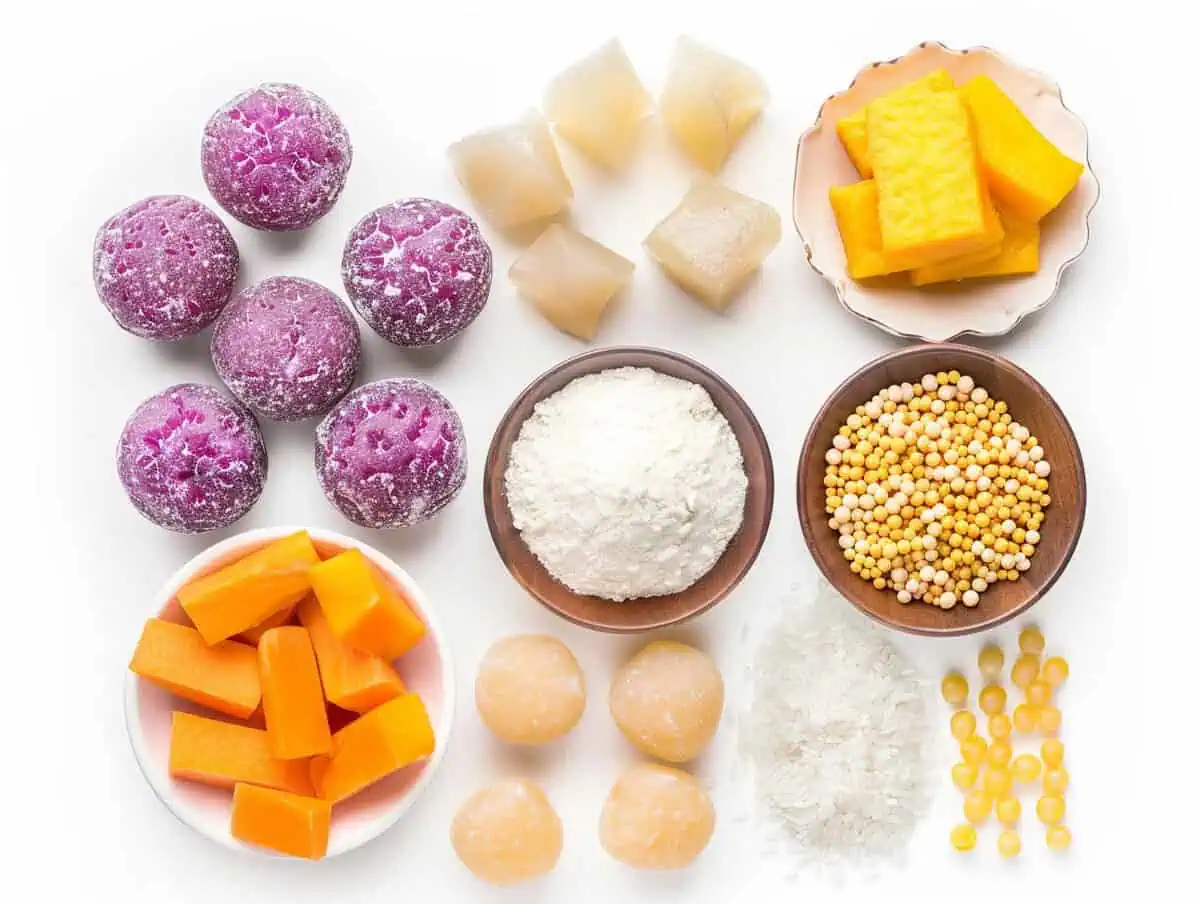
- 2 cups glutinous rice flour
- 1 cup water (for rice balls)
- 2-3 cups water (for cooking)
- 2 cans (400ml each) coconut milk or cream
- 1½ cups cooked tapioca pearls
- ¾ cup sugar (adjust to taste)
- 2 large sweet potatoes, peeled and cubed
- 4 ripe plantain bananas (saba), peeled and cubed
- 1 cup jackfruit strips (fresh or canned)
- Optional: food coloring for colorful bilo bilo
Equipment
- Large pot or Dutch oven
- Mixing bowl
- Measuring cups and spoons
- Wooden spoon or heat-resistant spatula
- Knife and cutting board
- Colander or strainer (for tapioca pearls)
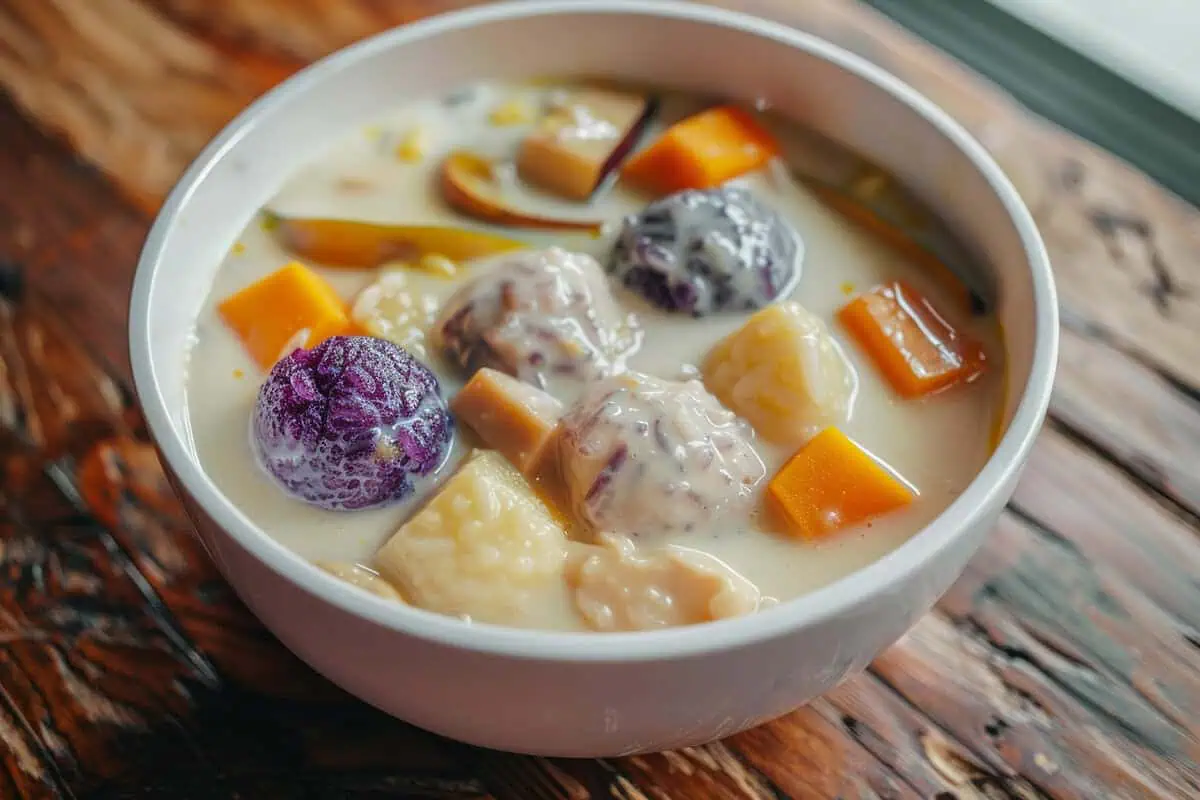
How To Make
- Prepare the sticky rice balls: In a mixing bowl, combine 2 cups glutinous rice flour with 1 cup water. Mix until it forms a soft, pliable dough. If desired, divide the dough and add food coloring to create colorful balls. Take small portions (about ½ tablespoon each) and roll between your palms to form smooth balls. Set aside.
- Prepare the base: In a large pot, combine 2 cups water, coconut milk, and sugar. Bring to a gentle boil over medium heat, stirring occasionally to dissolve the sugar.
- Cook the root crops: Add the sweet potato cubes to the coconut mixture and cook for about 3 minutes, stirring occasionally. Next, add the plantain banana cubes and continue cooking for another 3 minutes.
- Add the bilo bilo: Once the sweet potatoes and bananas are almost tender, gently drop the sticky rice balls into the pot. Simmer for about 5 minutes until they float to the surface, which indicates they're fully cooked. Stir gently to prevent sticking.
- Finish the dish: Add the jackfruit strips and cooked tapioca pearls. Let simmer for another 3-5 minutes until all ingredients are tender and the mixture has slightly thickened. Note that it will continue to thicken after removing from heat.
- Serve: Enjoy Ginataang Bilo Bilo hot as a comforting snack on cool days, or refrigerate and serve cold during warmer weather.

Tips from Lola's Kitchen
- For perfectly chewy bilo bilo: Make sure your dough isn't too wet or too dry. It should be soft and pliable but not sticky. If it's too sticky, add a little more glutinous rice flour.
- Creating colorful bilo bilo: Divide your dough into portions before adding food coloring. A little goes a long way - just a drop or two will give vibrant colors. Purple (ube) food coloring adds both color and flavor.
- For the best coconut flavor: Use coconut cream instead of regular coconut milk for a richer, more luxurious texture and taste.
- Tapioca pearl tip: Small tapioca pearls work best for this recipe. Pre-cooking them separately ensures they're perfectly transparent with no hard centers.
- Sweetness adjustment: Filipino desserts tend to be quite sweet. Feel free to start with less sugar and adjust to your taste preference.
Substitutions
- Sweet potatoes: Can use purple yam (ube), taro root (gabi), or even pumpkin/kabocha squash as alternatives.
- Plantains: Substitute with regular bananas, but reduce cooking time as they soften more quickly.
- Jackfruit: If unavailable, try using ripe mango chunks or pineapple pieces for a different but delicious flavor profile.
- Coconut milk: In a pinch, you can use regular milk or plant-based milk mixed with coconut extract, though the authentic flavor comes from real coconut milk.
- Glutinous rice flour: While not traditional, you can substitute with mochiko (Japanese sweet rice flour) if needed.
Troubleshooting
- Bilo bilo falling apart: Your dough might be too wet. Add more glutinous rice flour and knead well before forming balls.
- Too thin consistency: Simply simmer longer to reduce and thicken the mixture, or add a slurry of 1 tablespoon cornstarch dissolved in 2 tablespoons water.
- Too thick: Add more coconut milk or water to achieve your desired consistency.
- Bilo bilo not floating: They might need more cooking time. Be patient and continue to simmer until they rise to the surface.
- Fruits too firm: Different varieties may require different cooking times. Simply continue cooking until they reach your desired tenderness.
Storage & Reheating
- Refrigeration: Store leftovers in an airtight container in the refrigerator for up to 3 days. The flavors often improve overnight as they meld together.
- Freezing: While you can freeze Ginataang Bilo Bilo, the texture of the rice balls may change slightly upon thawing. Freeze in portion-sized containers for up to 1 month.
- Reheating: Warm gently on the stovetop over medium-low heat, stirring occasionally and adding a splash of water or coconut milk if it's too thick. Alternatively, microwave in 30-second intervals, stirring between each.

FAQ
Why are my bilo bilo (sticky rice balls) hard in the center?
They likely need more cooking time. Continue simmering until they float to the surface and appear slightly translucent.
Can I make Ginataang Bilo Bilo ahead of time?
Yes! It often tastes even better the next day as flavors develop. Just reheat gently or serve cold.
Is there a quick way to cook tapioca pearls?
Small tapioca pearls cook faster than large ones. The double-boiling method described in the recipe ensures they cook through properly without excessive time.
How do I know when sweet potatoes are done?
They should be fork-tender but still hold their shape. Overcooking will cause them to disintegrate into the mixture.
Can I reduce the sugar?
Absolutely. Traditional recipes tend to be quite sweet, but you can adjust to your preference. Start with half the amount and add more to taste.
What makes the bilo bilo chewy?
Glutinous rice flour (despite being gluten-free) contains high amounts of amylopectin, which creates that distinctive chewy texture when cooked.
Can I use a different type of flour for the bilo bilo?
For authentic texture, glutinous rice flour is essential. Regular rice flour or wheat flour will not produce the same chewy result.
Where can I find jackfruit?
Look for canned jackfruit in syrup at Asian markets or international food sections of larger supermarkets. Fresh jackfruit is seasonal but becoming more widely available.
Related
Looking for other recipes like this? Try these:
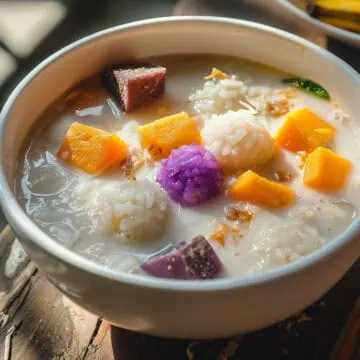
Ginataang Bilo Bilo (Sticky Rice Balls in Coconut Milk)
Ingredients
- 2 cups glutinous rice flour
- 1 cup water for rice balls
- 2-3 cups water for cooking
- 2 cans 400ml each coconut milk or cream
- 1½ cups cooked tapioca pearls
- ¾ cup sugar adjust to taste
- 2 large sweet potatoes peeled and cubed
- 4 ripe plantain bananas saba, peeled and cubed
- 1 cup jackfruit strips fresh or canned
- Optional: food coloring for colorful bilo bilo
Instructions
- Prepare the sticky rice balls: In a mixing bowl, combine 2 cups glutinous rice flour with 1 cup water. Mix until it forms a soft, pliable dough. If desired, divide the dough and add food coloring to create colorful balls. Take small portions (about ½ tablespoon each) and roll between your palms to form smooth balls. Set aside.
- Prepare the base: In a large pot, combine 2 cups water, coconut milk, and sugar. Bring to a gentle boil over medium heat, stirring occasionally to dissolve the sugar.
- Cook the root crops: Add the sweet potato cubes to the coconut mixture and cook for about 3 minutes, stirring occasionally. Next, add the plantain banana cubes and continue cooking for another 3 minutes.
- Add the bilo bilo: Once the sweet potatoes and bananas are almost tender, gently drop the sticky rice balls into the pot. Simmer for about 5 minutes until they float to the surface, which indicates they're fully cooked. Stir gently to prevent sticking.
- Finish the dish: Add the jackfruit strips and cooked tapioca pearls. Let simmer for another 3-5 minutes until all ingredients are tender and the mixture has slightly thickened. Note that it will continue to thicken after removing from heat.
- Serve: Enjoy Ginataang Bilo Bilo hot as a comforting snack on cool days, or refrigerate and serve cold during warmer weather.
Tips from Lola's Kitchen
- For perfectly chewy bilo bilo: Make sure your dough isn't too wet or too dry. It should be soft and pliable but not sticky. If it's too sticky, add a little more glutinous rice flour.
- Creating colorful bilo bilo: Divide your dough into portions before adding food coloring. A little goes a long way - just a drop or two will give vibrant colors. Purple (ube) food coloring adds both color and flavor.
- For the best coconut flavor: Use coconut cream instead of regular coconut milk for a richer, more luxurious texture and taste.
- Tapioca pearl tip: Small tapioca pearls work best for this recipe. Pre-cooking them separately ensures they're perfectly transparent with no hard centers.
- Sweetness adjustment: Filipino desserts tend to be quite sweet. Feel free to start with less sugar and adjust to your taste preference.
The Story Behind Ginataang Bilo Bilo
Ginataang Bilo Bilo holds a special place in Filipino culinary tradition, with roots that stretch back generations across the Philippine islands. This beloved dessert embodies the Filipino's resourcefulness and creativity in crafting delicious treats from local ingredients that were readily available even in rural areas.
In traditional Filipino households, particularly in provincial regions, families would often gather to prepare this dish together. The process of making bilo bilo (sticky rice balls) was especially communal – I remember stories of grandmothers sitting with their children and grandchildren, everyone rolling small pieces of sticky rice dough between their palms to form perfect little balls. This tradition created not just a delicious dessert, but precious family memories.
The name itself tells its story – "ginataan" refers to anything cooked in "gata" (coconut milk), a staple ingredient in Filipino cuisine due to the abundance of coconut trees throughout the archipelago. "Bilo bilo" is an affectionate, repetitive term that describes the round shape of the glutinous rice balls, with the repetition emphasizing their plurality and importance to the dish.
What makes Ginataang Bilo Bilo particularly special is how it showcases the natural bounty of the Philippines. Sweet potatoes, plantains, and jackfruit grow abundantly in the tropical climate, making this dessert economical yet satisfying. In the past, families would use whatever root crops and fruits were in season, creating variations that reflected regional availability and preferences.
During rainy seasons, which are frequent in the tropical Philippines, Ginataang Bilo Bilo became especially popular as a warming comfort food. The combination of sweet, creamy coconut milk and chewy rice balls offered the perfect antidote to gloomy weather. Meanwhile, during summer months, many Filipino families enjoy it chilled as a refreshing treat to combat the intense heat.
Today, Ginataang Bilo Bilo remains a fixture at Filipino gatherings, fiestas, and family reunions. While modern convenience has made preparation easier (with pre-packaged glutinous rice flour replacing the labor-intensive process of grinding rice by hand), the essence of the dish remains unchanged – a sweet, comforting celebration of Filipino flavors that brings people together. Every spoonful connects us to generations of tradition and the simple joy of sharing homemade food with loved ones.






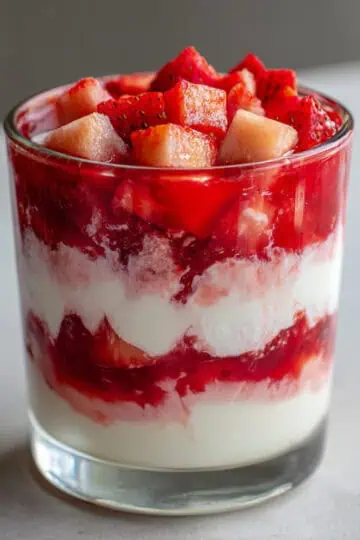
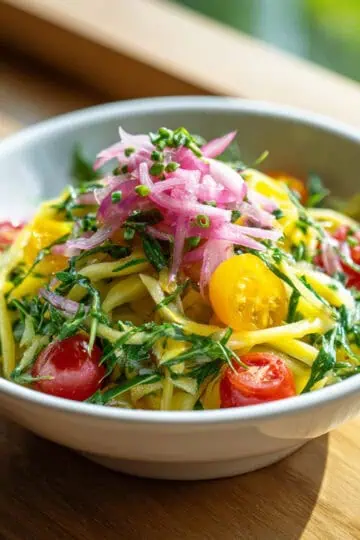

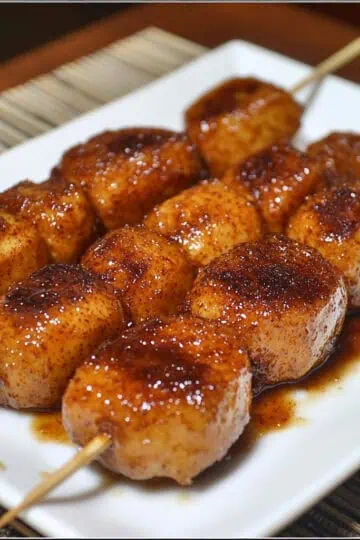
Comments
No Comments